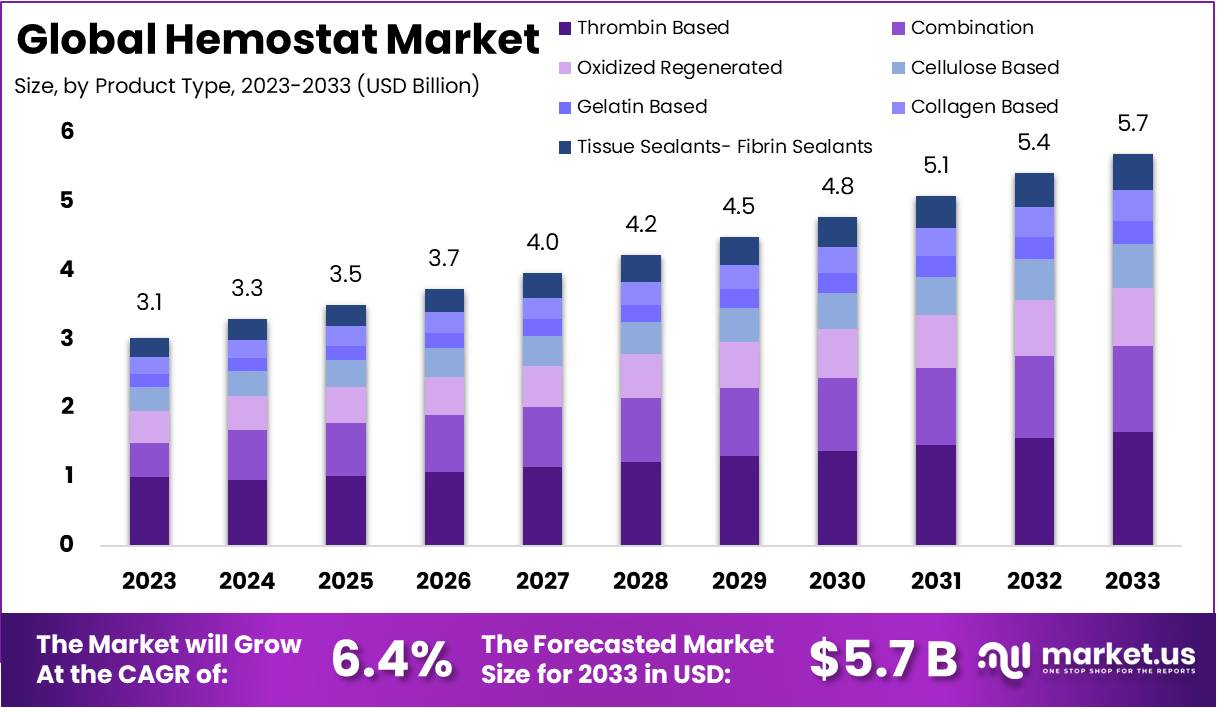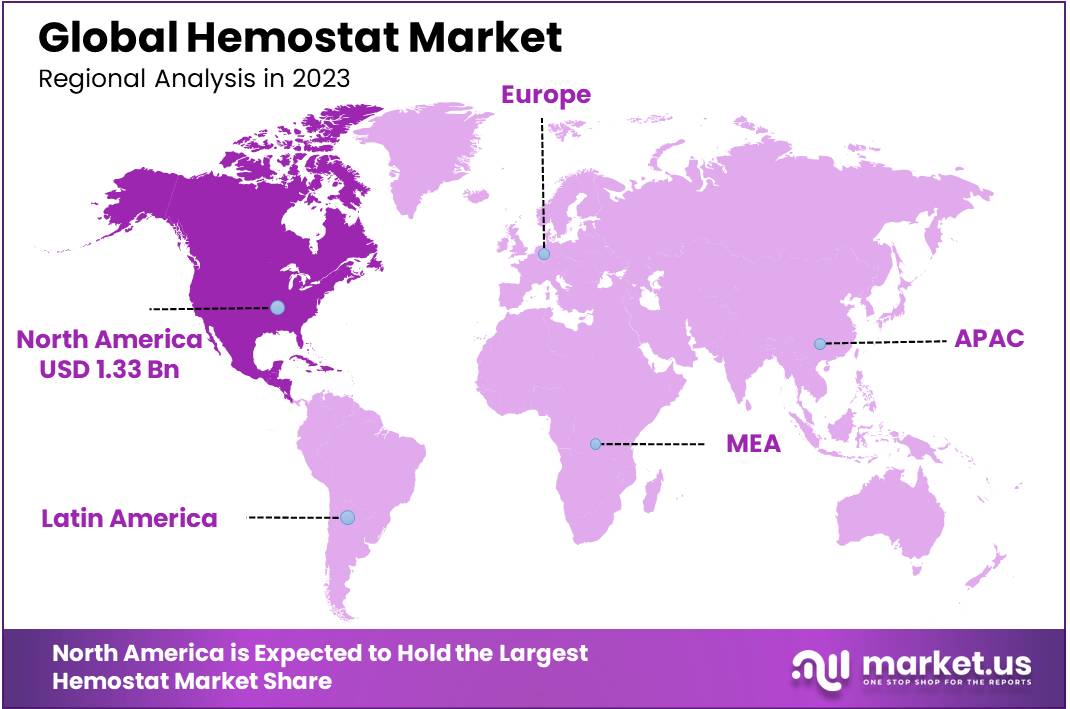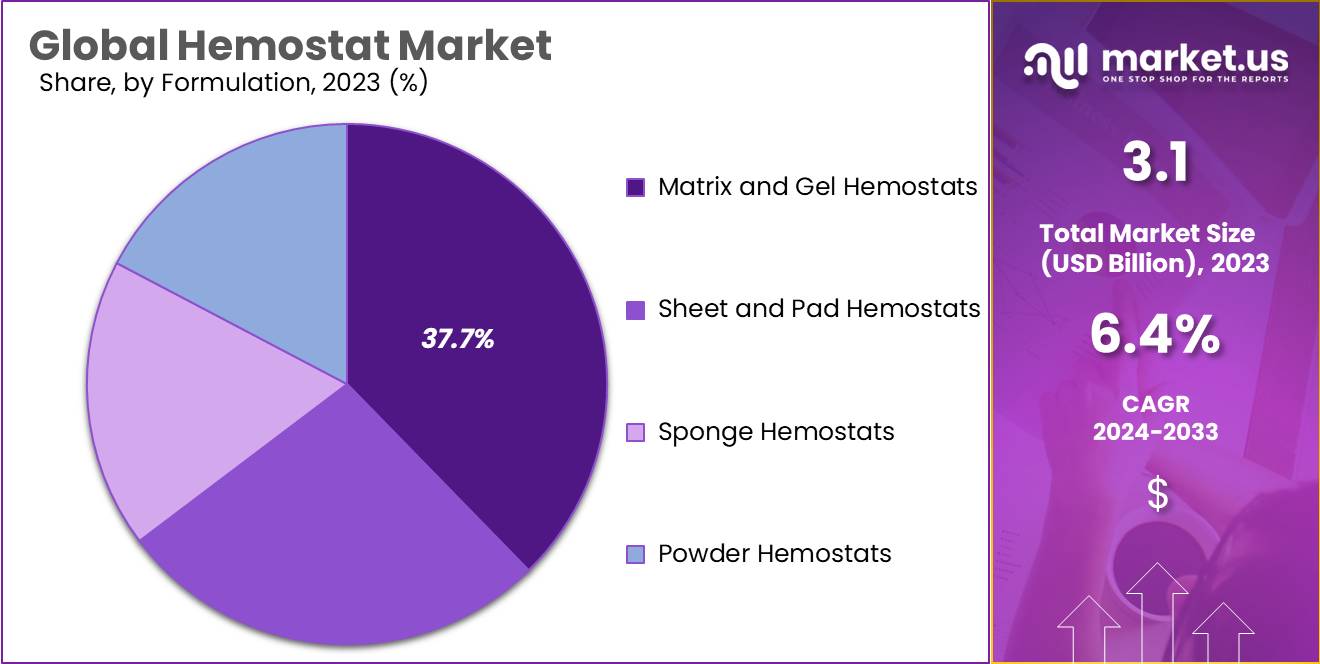New York, Feb. 14, 2024 (GLOBE NEWSWIRE) -- According to Market.us, the global Hemostat Market size is forecasted to exceed USD 5.7 Billion by 2033, with a promising CAGR of 6.4% from 2024 to 2033.
The global hemostats market encompasses a wide array of medical devices and pharmaceutical products aimed at controlling bleeding and promoting hemostasis during surgical procedures or in cases of traumatic injuries. Hemostats play a critical role in various medical fields, including surgery, interventional radiology, and emergency medicine. The market comprises a diverse range of products such as topical hemostats, absorbable hemostats, and mechanical hemostats, each offering unique mechanisms to achieve hemostasis.
Access a PDF sample report for essential market insights, trends, drivers, and challenges: https://market.us/report/hemostat-market/request-sample/

Key Takeaway:
- By product, the segments observed in the market are thrombin-based, combination, oxidized generated, cellulose based, gelatin-based, collagen based, tissue sealants – fibrin sealants. Among these segments, thrombin-based hemostats stood out as the most lucrative in 2023 due to increased R&D efforts, rising demand for surgical applications, and the proliferation of surgical hemostat tools.
- Within the formulation analysis, the matrix and gel hemostats segment held significant market share, amounting to 37.7%, propelled by its effectiveness in various surgical procedures.
- In terms of application, orthopedic surgery dominated the market, while the surgery segment leads in indications. The segment secured a market share of 38.6%.
- The hospital segment emerged as the dominant end-user in 2023, accounting for a substantial market share, driven by the widespread use of hemostats in surgical procedures across healthcare facilities, including hospitals, clinics, and ambulatory surgery centers.
- Region wise, North America remained as leading contributor with the market share of 48.1% in 2023.
Factors Affecting the Growth of the Hemostat Market:
- Factors driving the growth of the global hemostats market include the increasing number of surgical procedures worldwide, rising cases of traumatic injuries and accidents, and the growing demand for minimally invasive surgical techniques. Additionally, advancements in hemostatic agents, including the development of biodegradable and synthetic materials, are fueling market expansion.
- Furthermore, the rising prevalence of chronic diseases such as cardiovascular diseases, cancer, and liver diseases, which often require surgical interventions, contributes to the demand for hemostats. Moreover, the expanding geriatric population, who are more prone to surgical procedures and chronic illnesses, also drives market growth.
- On the technological front, innovations in hemostatic technologies, including the introduction of advanced hemostatic agents and hemostatic devices with improved efficacy and safety profiles, are propelling market growth. Furthermore, increased investments in research and development activities by key market players and collaborations between pharmaceutical companies and research institutions are fostering innovation in the hemostats market.
Top Trends in the Global Hemostat Market:
- An emerging trend in the hemostats market is the increasing adoption of advanced hemostatic agents over traditional products like sutures and staples. These advanced agents offer improved hemostasis, reduced complications, and faster healing compared to conventional options. Biologic hemostatic agents, including fibrin and collagen-based products, are gaining popularity due to their effectiveness and safety, mimicking the body's natural clotting process while minimizing adverse reactions.
- The rise of minimally invasive surgical procedures has spurred a significant demand for hemostatic agents suitable for use in such techniques. Hemostatic agents that can be delivered through small incisions or catheters are particularly sought after in these scenarios. Additionally, combination products, which integrate hemostatic agents with sealants or adhesives, are gaining traction for their ability to control bleeding and seal tissue effectively. By consolidating multiple functions into one product, these hybrid solutions simplify surgical processes, offering convenience to healthcare practitioners and patients alike.
Market Growth:
The hemostat market is experiencing steady growth driven by several key factors. Rising prevalence of chronic diseases and increasing surgical procedures worldwide contribute to the expanding demand for hemostatic agents. Technological advancements in hemostat products, including the development of innovative formulations and delivery systems, further stimulate market growth by improving efficacy and patient outcomes. Moreover, growing investments in healthcare infrastructure, particularly in emerging economies, enhance access to surgical interventions and drive the adoption of hemostats.
Additionally, increasing awareness among healthcare professionals about the benefits of hemostatic agents in minimizing blood loss and reducing surgical complications fuels market expansion. Furthermore, strategic initiatives by key market players, such as mergers, acquisitions, and product launches, contribute to market growth by expanding product portfolios and market reach. As a result, the hemostat market is projected to continue its upward trajectory in the coming years, propelled by these favorable growth drivers.
Macroeconomic Factors:
The hemostat market is significantly influenced by various macroeconomic factors. Economic indicators such as GDP growth rates, healthcare expenditure, and government healthcare policies play crucial roles in shaping market dynamics. Increasing healthcare spending and GDP growth typically correlate with higher demand for healthcare services and medical technologies, including hemostats. Additionally, regulatory frameworks and reimbursement policies directly impact market accessibility and adoption rates. Economic downturns or fluctuations in healthcare funding may temporarily constrain market growth.
Moreover, demographic trends such as aging populations contribute to the prevalence of chronic diseases and surgical interventions, driving the demand for hemostatic products. Overall, macroeconomic stability, healthcare infrastructure development, and regulatory frameworks profoundly influence the trajectory of the hemostat market.
Regional Analysis:
North America is poised to lead the global hemostats market with an estimated market share of 48.1% during the forecast period. The region's dominance is attributed to its high prevalence of chronic diseases, increasing demand for advanced medical technologies, and well-established healthcare infrastructure, particularly in the United States and Canada. Europe is anticipated to hold a significant share of the hemostats market, driven by a rising number of surgical procedures, an aging population, and escalating healthcare spending, with key markets including the United Kingdom, Germany, and France.
In contrast, the Asia Pacific region presents substantial growth potential in the hemostats market due to the increasing prevalence of chronic diseases and advancements in healthcare infrastructure. Latin America is expected to contribute significantly to the global hemostats market, fueled by a rise in chronic diseases, expanding healthcare spending, and improved healthcare infrastructure, with Brazil and Mexico emerging as key markets in the region. While the Middle East and Africa may hold a smaller market share for hemostats due to limited healthcare infrastructure and lower spending levels, investments in healthcare, rising chronic disease rates, and growing awareness of advanced medical technologies could drive market growth in this region.

Unlock the potential of our report for your business strategy: https://market.us/report/hemostat-market/#inquiry
Scope of the Report
| Report Attributes | Details |
| Market Value (2023) | USD 3.1 Billion |
| Forecast Revenue 2033 | USD 5.7 Billion |
| CAGR (2024 to 2033) | 6.4% |
| North America Revenue Share | 48.1% |
| Base Year | 2023 |
| Historic Period | 2018 to 2022 |
| Forecast Year | 2024 to 2033 |
Market Drivers:
The hemostats market is driven by several key factors. Firstly, the rising prevalence of chronic diseases necessitates surgical procedures where hemostats are essential in controlling bleeding and minimizing blood loss, thus contributing to increased demand. Secondly, the growing geriatric population, prone to chronic diseases and injuries, requires more frequent surgical interventions, further boosting the demand for hemostats. Thirdly, ongoing technological advancements, including nanotechnology and biotechnology, are driving innovation in hemostat products, fueling market growth.
Lastly, the rising number of surgeries globally, particularly in emerging economies with improving healthcare infrastructure and increased awareness of surgical benefits, is leading to higher demand for hemostats, evident through increased usage across various surgical interventions.
Market Restraints:
Several factors restrain the global hemostat market. Firstly, stringent regulatory requirements govern the development and approval of new hemostatic agents, leading to potential delays in product commercialization and increased development costs. Secondly, limited reimbursement options in certain countries may restrict the demand for hemostatic agents as patients and healthcare providers may face financial barriers. Additionally, competition from alternative therapies like sutures, staples, and fibrin sealants poses a challenge to hemostat market growth, as these alternatives may offer comparable effectiveness and lower costs, thereby reducing the market share of hemostatic agents.
Market Opportunities:
The hemostats market presents several growth opportunities. Firstly, the increasing number of surgical procedures worldwide fuels the demand for hemostatic agents to effectively control bleeding and reduce complications, offering a promising avenue for market expansion. Secondly, advancements in hemostatic technology, including nanotechnology and biologics, hold significant potential to broaden the scope of the hemostats market by offering innovative solutions. Thirdly, the rising popularity of minimally invasive surgical techniques necessitates hemostatic agents suitable for use in these procedures, creating a niche market segment.
Moreover, emerging markets with improving healthcare infrastructure, rising healthcare expenditures, and greater awareness of advanced medical technologies provide fertile ground for hemostats market growth globally. Lastly, the aging population, coupled with the prevalence of chronic illnesses, drives the demand for surgical interventions, further propelling the growth of the hemostats market to meet evolving healthcare needs.
Gain immediate access to our exclusive research report: https://market.us/purchase-report/?report_id=51144
Report Segmentation of the Hemostat Market:
Product Type Insight
The global hemostats market is segmented into various product types, including thrombin-based, combination, oxidized regenerated cellulose-based, gelatin-based, collagen-based hemostats, and tissue sealants-fibrin sealants. Among these segments, the thrombin-based category stood out as the most lucrative in the market with a market share of 28.9%. This dominance is expected to continue over the forecast period, driven by increased research and development efforts in the pharmaceutical and medical device industries, growing demand for hemostatic agents during surgical procedures, and a surge in the utilization of surgical hemostat tools. As surgical rates continue to rise globally and numerous pharmaceutical companies invest in hemostat research projects, collagen-based hemostats are also poised for rapid market expansion in the foreseeable future.
Formulation Insight
In the global hemostats market, formulations are categorized into matrix and gel hemostats, sheet & pad hemostats, sponge hemostats, and powder hemostats. Among these formulations, the matrix and gel hemostats segment emerges as the most lucrative, capturing an estimated market share of 37.7%. Additionally, the powder hemostats segment is anticipated to experience substantial growth throughout the forecast period. This growth is attributed to the rising prevalence of cardiovascular disorders and increased utilization during surgical procedures, reflecting a growing demand for effective hemostatic solutions in healthcare settings.

Application Insight
In the application analysis of the hemostats market, various segments include orthopedic surgery, general surgery, neurological surgery, cardiovascular surgery, reconstructive surgery, gynecological surgery, trauma, plastic surgery, and other applications. Among these segments, orthopedic surgery remained the dominant application in the market with 38.6%. Hemostats are also utilized in dental and cosmetic surgeries to manage bleeding effectively. Moreover, they play a crucial role in trauma management, helping control bleeding in emergencies such as gunshot wounds, car accidents, and severe injuries. Hemostats serve to stabilize the patient's condition by controlling bleeding until they receive proper medical attention.
Indication Insight
In the indication analysis of the hemostats market, the segments are categorized into closures and surgery. Among these, the surgery segment emerged as the dominant force in the market with a market share of 61.4%. With its extensive application across various surgical procedures, the surgery segment is expected to maintain its dominance throughout the forecast period. Hemostats play a crucial role in surgical interventions, aiding in the control of bleeding and ensuring optimal surgical outcomes. As surgical procedures continue to rise globally and advancements in surgical techniques drive demand for effective hemostatic solutions, the surgery segment is poised for sustained growth. The widespread adoption of hemostats in diverse surgical specialties underscores their significance in modern healthcare settings, reinforcing the dominance of the surgery segment in the hemostats market.
End-User Insight
In the end-user analysis of the hemostats market, the segmentation includes ambulatory centers, hospitals, clinics, community healthcare, healthcare, and other end-users. Among these segments, the hospital segment emerged as the most dominant and lucrative, commanding a significant market share of 49.2%. Hemostats play a pivotal role in surgical procedures and emergency situations within hospital settings, where they are utilized to control bleeding and mitigate the risk of excessive blood loss. Hospitals rely on hemostats not only for routine surgeries but also for trauma management and various medical interventions, highlighting their versatile applications in critical healthcare scenarios. Ambulatory surgery centers (ASCs) also leverage hemostats to ensure optimal patient outcomes during same-day surgical procedures by effectively managing bleeding and preventing complications.
Furthermore, hemostats find usage in dental clinics, academic and research institutions, and other healthcare providers, underscoring their widespread adoption across diverse healthcare settings. As hospitals continue to be at the forefront of surgical interventions and medical emergencies, the hospital segment is expected to maintain its dominance in the hemostats market due to the indispensable role of hemostatic agents in ensuring patient safety and successful surgical outcomes.
Access a PDF sample report for essential market insights, trends, drivers, and challenges: https://market.us/report/hemostat-market/request-sample/
Recent Development of the Hemostat Market:
- In July 2023, Baxter International Inc., a prominent player in surgical innovation, has introduced PERCLOT Absorbable Hemostatic Powder in the United States. PERCLOT is a passive, absorbable hemostatic powder intended for patients with intact coagulation to manage mild bleeding. This innovative product is designed to provide a convenient solution for surgical procedures by effectively promoting hemostasis.
- In August 2023, Teleflex Incorporated, a renowned global provider of medical technologies, has received clearance from the U.S. Food and Drug Administration (FDA) for the QuikClot Control+ Hemostatic Device to address mild and moderate bleeding in cardiac surgical procedures. Additionally, the clearance extends to bone surface bleeding subsequent to a sternotomy.
Market Segmentation:
By Product Type
- Thrombin Based
- Combination
- Oxidized Regenerated
- Cellulose Based
- Gelatin Based
- Collagen Based Hemostat
- Tissue Sealants- Fibrin Sealants
By Formulation
- Matrix and Gel Hemostats
- Sheet and Pad Hemostats
- Sponge Hemostats
- Powder Hemostats
By Application
- Orthopedic Surgery
- General Surgery
- Neurological Surgery
- Cardiovascular Surgery
- Reconstructive Surgery
- Gynecological Surgery
- Trauma
- Plastic Surgery
- Other
By Indication
- Closure
- Surgery
By End-User
- Ambulatory Surgical Centers
- Hospitals
- C0linics
- Community Healthcare
- Other End-Users
By Geography
- North America
- US
- Canada
- Europe
- Germany
- France
- The UK
- Spain
- Italy
- Russia
- Netherland
- Rest of Europe
- Asia Pacific
- China
- Japan
- South Korea
- India
- New Zealand
- Singapore
- Thailand
- Vietnam
- Rest of APAC
- Latin America
- Brazil
- Mexico
- Rest of Latin America
- Middle East & Africa
- South Africa
- Saudi Arabia
- UAE
- Rest of MEA
Competitive Landscape:
Various emerging key players are strategically focused on expanding their businesses in international markets through a variety of strategic initiatives. Many companies in the hemostats market are prioritizing the expansion of their current operations and research and development (R&D) facilities. Johnson & Johnson holds the top position in the global hemostats market, commanding a substantial market share. Through its subsidiary Ethicon, Inc., the company provides a diverse range of hemostats. Additionally, Baxter International Inc. and C.R. Bard, Inc. are prominent players in the market, offering a wide array of hemostatic products tailored for various surgical procedures.
Market Key Players:
- CR Bard Inc
- B Braun Melsungen AG
- Baxter International Inc
- Integra Life Sciences
- Marine Polymer Technologies Inc
- Teleflex
- Ethicon Inc
- Pfizer Inc
- Z-Medica LLC
- Gelita Medical GmbH
- Anika Therapeutics Inc
- Stryker
- Integra Lifesciences Corporation
- Johnson & Johnson Services Inc
- Other Key Players
Explore More Life Science Market Research Reports
- Surgical Sutures Market size is expected to be worth around USD 8.0 Billion by 2032 from USD 4.7 Billion in 2022
- Surgical Equipment Market size is expected to be worth around USD 36 Bn by 2032 from USD 16.7 Bn in 2022, growing at a CAGR of 8.2%.
- Surgical Navigation Systems Market size is expected to be worth around USD 1,517.0 Million by 2032 from USD 903 Million in 2022.
- Minimally Invasive Surgical Instruments Market is expected to be worth around USD 86.8 Bn by 2032, from USD 35.1 Bn in 2023
- Anti-Biofilm Wound Dressing Market accounted for USD 730 Mn and is expected to grow to around USD 1,799 Mn in 2032, at a CAGR of 9.7%
- Advanced Wound Dressing market was valued at USD 9,352.4 million in 2021. This number will increase at a CAGR of 5.5% between 2023-2032.
- Defibrillator Market accounted for USD 11.9 Bn and is to grow to around USD 24.8 billion in 2032. Bn 2023 and 2032, at a CAGR of 7.8%.
- Human Insulin Market size is expected to be worth around USD 46.7 Billion by 2033 from USD 29.2 Billion in 2023
- Oligonucleotide Synthesis Market size is expected to be worth around USD 44.9 Bn by 2033, growing at a CAGR of 17.3% from 2024 to 2033.
- Global Opioids Market size is expected to be worth around USD 29.5 Billion by 2033 from USD 22.2 Billion in 2023
About Us:
Market.US (Powered by Prudour Pvt Ltd) specializes in in-depth market research and analysis and has been proving its mettle as a consulting and customized market research company, apart from being a much sought-after syndicated market research report-providing firm. Market.US provides customization to suit any specific or unique requirement and tailor-makes reports as per request. We go beyond boundaries to take analytics, analysis, study, and outlook to newer heights and broader horizons.
Follow Us on LinkedIn
Our Blog:
